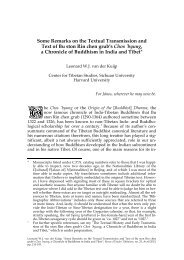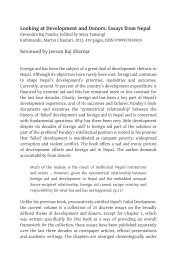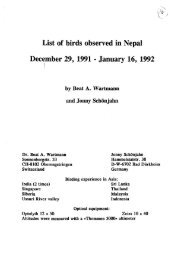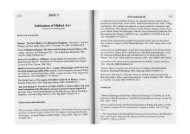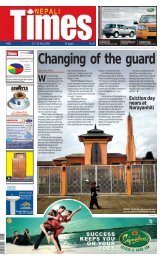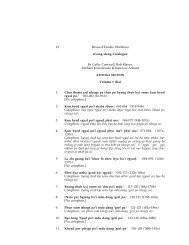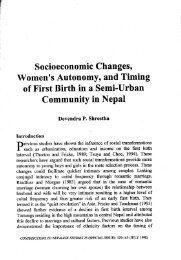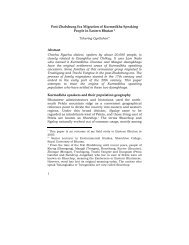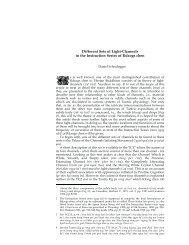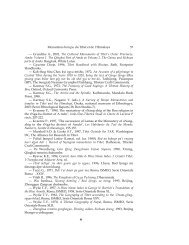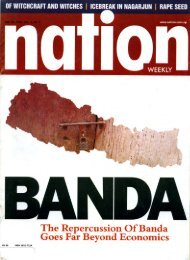Maoist gates in Jumla and Mugu districts: Illustrations of the ...
Maoist gates in Jumla and Mugu districts: Illustrations of the ...
Maoist gates in Jumla and Mugu districts: Illustrations of the ...
Create successful ePaper yourself
Turn your PDF publications into a flip-book with our unique Google optimized e-Paper software.
84 EBHR-41<br />
<strong>Maoist</strong> <strong>gates</strong> <strong>in</strong> <strong>Jumla</strong> <strong>and</strong> <strong>Mugu</strong> <strong>districts</strong>: <strong>Illustrations</strong> <strong>of</strong><br />
<strong>the</strong> ‘People’s War’<br />
Satya Shrestha-Schipper<br />
Dur<strong>in</strong>g <strong>the</strong> ten years <strong>of</strong> its <strong>in</strong>surgency (1996-2006) <strong>the</strong> Nepal Communist<br />
Party (<strong>Maoist</strong>) made extensive use <strong>of</strong> images, ei<strong>the</strong>r to convey its ideology<br />
or to advertise its presence <strong>in</strong> a locality. 1 The <strong>Maoist</strong>s <strong>of</strong>ten used public,<br />
private <strong>and</strong> religious properties as places to plaster posters, write<br />
slogans <strong>and</strong> erect <strong>the</strong>ir party flag. 2 Besides <strong>the</strong>se images, <strong>the</strong> <strong>Maoist</strong>s also<br />
constructed <strong>gates</strong> <strong>and</strong> chautārās (platforms or rest<strong>in</strong>g places for travellers). 3<br />
In fact, build<strong>in</strong>g chautārās <strong>in</strong> <strong>the</strong> name <strong>of</strong> a dead person is not only a <strong>Maoist</strong><br />
phenomenon, it has long been a part <strong>of</strong> Nepalese tradition. A chautārā is<br />
<strong>of</strong>ten built to keep <strong>the</strong> name <strong>of</strong> a deceased person alive, <strong>and</strong> <strong>gates</strong> are <strong>of</strong>ten<br />
erected to welcome participants <strong>and</strong> dignitaries to a particular event;<br />
sometimes permanent <strong>gates</strong> are built to welcome visitors. The <strong>Maoist</strong> <strong>gates</strong><br />
are built, particularly <strong>in</strong> <strong>Jumla</strong> <strong>and</strong> <strong>Mugu</strong> <strong>districts</strong>, to commemorate fallen<br />
comrades <strong>and</strong> to welcome <strong>in</strong>habitants <strong>of</strong> <strong>the</strong> region <strong>and</strong> outsiders, as well<br />
as to demarcate territorial divisions. The <strong>gates</strong> are <strong>of</strong>ten constructed on<br />
ma<strong>in</strong> paths ra<strong>the</strong>r than with<strong>in</strong> a village; consequently, every passer-by<br />
has to walk through <strong>the</strong>m. Even if <strong>the</strong> <strong>in</strong>habitants want to bypass <strong>the</strong>m,<br />
as <strong>the</strong>y do elsewhere, 4 <strong>the</strong>y are not able to do so, because <strong>gates</strong> are <strong>of</strong>ten<br />
constructed cover<strong>in</strong>g both sides <strong>of</strong> <strong>the</strong> path. Fur<strong>the</strong>rmore, I have never<br />
heard that villagers wanted to go around <strong>the</strong> <strong>gates</strong> to avoid walk<strong>in</strong>g<br />
through <strong>the</strong>m. These <strong>gates</strong> were <strong>of</strong>ten built by villagers on <strong>the</strong> <strong>Maoist</strong>s’<br />
orders; some were built by <strong>the</strong> <strong>Maoist</strong>s <strong>the</strong>mselves.<br />
S<strong>in</strong>ce <strong>the</strong> peace accord was signed by <strong>the</strong> CPN (<strong>Maoist</strong>) <strong>and</strong> <strong>the</strong><br />
Government <strong>in</strong> 2006, most <strong>of</strong> <strong>the</strong> <strong>gates</strong> built by <strong>Maoist</strong>s have become<br />
dilapidated; only a few were still <strong>in</strong> good condition <strong>in</strong> 2009. Some <strong>of</strong> <strong>the</strong><br />
1 Fieldwork for this research was f<strong>in</strong>anced by <strong>the</strong> ANR programme on <strong>the</strong> People’s War<br />
coord<strong>in</strong>ated by Marie Lecomte-Tilou<strong>in</strong>e.<br />
2 On <strong>the</strong> use <strong>of</strong> images <strong>in</strong> <strong>the</strong> People’s war by <strong>Maoist</strong>s as well as by <strong>the</strong> Army, see M.<br />
Lecomte-Tilou<strong>in</strong>e <strong>and</strong> P. Ramirez, 2006, ‘La guerre du Peuple en Images’ <strong>in</strong> Le maoïsme au<br />
Népal. Lectures d’une revolution, edited by Brigitte Ste<strong>in</strong>mann. Paris: CNRS, pp. 88-109.<br />
3 They are <strong>of</strong>ten constructed to commemorate a deceased.<br />
4 Cf. Lecomte-Tilou<strong>in</strong>e <strong>and</strong> Ramirez (no 2): 90.<br />
European Bullet<strong>in</strong> <strong>of</strong> Himalayan Research 41: 84-99 (2012)
Shrestha-Schipper<br />
85<br />
<strong>gates</strong> I saw <strong>in</strong> 2007 had disappeared by 2009, <strong>and</strong> <strong>in</strong> some places new <strong>gates</strong><br />
had been constructed. Gates are <strong>of</strong>ten decorated with communist symbols<br />
such as <strong>the</strong> hammer <strong>and</strong> sickle <strong>and</strong> portraits <strong>of</strong> communist leaders.<br />
The edifices also <strong>of</strong>ten bear communist slogans <strong>and</strong> <strong>the</strong> names <strong>of</strong> fallen<br />
comrades. In <strong>the</strong> follow<strong>in</strong>g pages I will present a series <strong>of</strong> <strong>gates</strong> built by<br />
<strong>Maoist</strong>s; <strong>the</strong> pictures were taken between 2006 <strong>and</strong> 2009 <strong>in</strong> <strong>Jumla</strong> <strong>and</strong><br />
<strong>Mugu</strong> <strong>districts</strong>, <strong>and</strong> are reproduced toge<strong>the</strong>r at <strong>the</strong> end <strong>of</strong> <strong>the</strong> text. The<br />
architecture <strong>of</strong> <strong>the</strong> <strong>gates</strong> changes as we move from one valley to ano<strong>the</strong>r.<br />
The text is divided accord<strong>in</strong>g to district: we move from <strong>Jumla</strong> valley to<br />
Nagma village, <strong>the</strong>n upstream to <strong>the</strong> S<strong>in</strong>ja valley, <strong>and</strong> f<strong>in</strong>ally to <strong>Mugu</strong><br />
district.<br />
<strong>Jumla</strong> district<br />
Photo 1. Lamra village [<strong>in</strong> 2007]<br />
The wooden gate built <strong>of</strong> timber is erected on <strong>the</strong> ma<strong>in</strong> path <strong>in</strong> Lamra<br />
village <strong>in</strong> <strong>Jumla</strong> valley. It is <strong>the</strong> first gate I came across while head<strong>in</strong>g west<br />
from <strong>Jumla</strong> bazar (it is located two to three hours walk west <strong>of</strong> <strong>the</strong> district<br />
headquarters known as <strong>Jumla</strong> Bazar or Khalanga, <strong>in</strong> <strong>the</strong> direction <strong>of</strong><br />
Kalikot district). Dur<strong>in</strong>g <strong>the</strong> <strong>Maoist</strong> heyday, this village was <strong>the</strong> beg<strong>in</strong>n<strong>in</strong>g<br />
<strong>of</strong> <strong>the</strong> <strong>Maoist</strong> territory, <strong>and</strong> it was <strong>in</strong> this village that <strong>the</strong> <strong>in</strong>surgents <strong>and</strong><br />
<strong>the</strong> government forces regularly clashed. The gate was constructed on <strong>the</strong><br />
ma<strong>in</strong> path that passes through <strong>the</strong> village. It looked neglected <strong>in</strong> 2007 <strong>and</strong><br />
had completely disappeared by <strong>the</strong> time <strong>of</strong> my follow up visit <strong>in</strong> 2009.<br />
Photo 2. Tato Pani [<strong>in</strong> 2009]<br />
This gate, built <strong>of</strong> stone <strong>and</strong> cement, 5 is constructed <strong>in</strong> Tato Pani village,<br />
situated three to four hours walk to <strong>the</strong> west <strong>of</strong> <strong>Jumla</strong> Bazar. The gate is<br />
built over narrow stone steps which lead to <strong>the</strong> hot water spr<strong>in</strong>g (Tato<br />
Pani 6 ) bath<strong>in</strong>g area; all <strong>the</strong> pilgrims have to walk through <strong>the</strong> gate if <strong>the</strong>y<br />
want to ba<strong>the</strong> <strong>in</strong> <strong>the</strong> spr<strong>in</strong>g. Tato Pani is a very popular bath<strong>in</strong>g area. It is<br />
known to have miraculous powers to cure sickness such as asthma <strong>and</strong><br />
5 Cement is rarely used for construction <strong>in</strong> <strong>the</strong> region. Because <strong>of</strong> unreliable<br />
transportation, cement is difficult to get <strong>in</strong> <strong>the</strong> local market; if it is available, <strong>the</strong> price<br />
is very high. Stone, clay <strong>and</strong> wood are generally used as construction materials <strong>in</strong><br />
this area.<br />
6 The village is named after <strong>the</strong> Tato Pani (hot water spr<strong>in</strong>g) bath<strong>in</strong>g area.
86 EBHR-41<br />
arthritis. Thus, <strong>the</strong> <strong>in</strong>habitants <strong>of</strong> <strong>Jumla</strong> <strong>and</strong> surround<strong>in</strong>g <strong>districts</strong> come to<br />
take a bath <strong>in</strong> this hot spr<strong>in</strong>g at least once <strong>in</strong> <strong>the</strong>ir lifetime.<br />
Both pillars <strong>of</strong> <strong>the</strong> gate are used as surfaces on which to write <strong>and</strong><br />
rewrite <strong>Maoist</strong> slogans. These are written on top <strong>of</strong> older slogans that<br />
have been partially erased; <strong>the</strong>refore, some <strong>of</strong> <strong>the</strong>m are difficult to<br />
decipher. The slogan on <strong>the</strong> left pillar reads: ‘Long live Marxism, Len<strong>in</strong>ism,<br />
Maoism <strong>and</strong> Prach<strong>and</strong>a Path - CPN-Maobadi (Mārksbād, Len<strong>in</strong>bād, Māobād<br />
ra Prach<strong>and</strong>apath j<strong>in</strong>dābād),’ <strong>and</strong> <strong>the</strong> one on <strong>the</strong> right pillar reads: ‘Give us<br />
rice <strong>and</strong> salt, o<strong>the</strong>rwise give up power...’ (cāmal, nun de natra sattā chod...).’<br />
The slogan on <strong>the</strong> right pillar is a poignant expression <strong>of</strong> <strong>the</strong> reality <strong>of</strong><br />
<strong>the</strong> region. The region does not produce enough rice to feed <strong>the</strong> whole<br />
district all year round <strong>and</strong> salt has to be brought <strong>in</strong> from <strong>the</strong> Tarai. To<br />
compensate for <strong>the</strong> rice <strong>and</strong> salt deficit <strong>the</strong> government regularly<br />
distributes subsidised rice <strong>and</strong> salt to each family <strong>in</strong> <strong>the</strong> region. However,<br />
due to <strong>the</strong> government’s <strong>in</strong>competence <strong>and</strong> corruption <strong>the</strong> villagers do<br />
not receive <strong>the</strong>ir quotas on time; sometimes, <strong>the</strong>y spend days <strong>in</strong> district<br />
headquarters before <strong>the</strong>y receive <strong>the</strong>ir share.<br />
Eas<strong>in</strong>g <strong>the</strong> distribution <strong>of</strong> rice <strong>and</strong> salt is a favourite promise <strong>of</strong> political<br />
leaders. However, although <strong>the</strong> government decentralised distribution to<br />
certa<strong>in</strong> VDC <strong>of</strong>fices for a few years, this was once aga<strong>in</strong> centralised to <strong>the</strong><br />
district headquarters because <strong>of</strong> <strong>the</strong> <strong>Maoist</strong> <strong>in</strong>surgency.<br />
Photo 3. Nagma village [2007]<br />
This wooden gate was built on <strong>the</strong> ma<strong>in</strong> path <strong>in</strong> Nagma village lead<strong>in</strong>g<br />
towards <strong>the</strong> S<strong>in</strong>ja valley. The village st<strong>and</strong>s on <strong>the</strong> border with Kalikot at<br />
a place where two major rivers (<strong>the</strong> Tila from <strong>Jumla</strong> valley <strong>and</strong> <strong>the</strong> S<strong>in</strong>ja<br />
from S<strong>in</strong>ja valley), come toge<strong>the</strong>r <strong>and</strong> flow westward to Kalikot as <strong>the</strong> Tila<br />
river. It is an important village for Jumli migrants return<strong>in</strong>g from sou<strong>the</strong>rn<br />
parts <strong>of</strong> Nepal. Because <strong>the</strong>y mistrust <strong>the</strong> <strong>in</strong>habitants <strong>of</strong> neighbour<strong>in</strong>g<br />
<strong>districts</strong>, most return<strong>in</strong>g migrants try to cross Kalikot district as soon as<br />
possible to reach this village, where <strong>the</strong>y usually spend a night before<br />
head<strong>in</strong>g to <strong>the</strong>ir own villages <strong>in</strong> <strong>Jumla</strong> valley or S<strong>in</strong>ja valley.<br />
This gate st<strong>and</strong>s as a welcome gate to S<strong>in</strong>ja valley <strong>and</strong> is constructed<br />
by <strong>the</strong> NCP (<strong>Maoist</strong>) Kalikot district. It reads: ‘We warmly welcome you all-<br />
NCP <strong>Maoist</strong> Kalikot’ (ehãharuko āgamanko hārdik swāgat gardachau-Ne.ka.pā.<br />
māobādī Kālikot). The architecture <strong>of</strong> <strong>the</strong> gate is very different from <strong>the</strong><br />
o<strong>the</strong>r <strong>Maoist</strong> <strong>gates</strong> <strong>in</strong> <strong>Jumla</strong> district but very similar to <strong>the</strong> <strong>Maoist</strong> <strong>gates</strong>
Shrestha-Schipper<br />
87<br />
<strong>in</strong> <strong>Mugu</strong> district. The gate has three dist<strong>in</strong>ct steeples, <strong>and</strong> <strong>the</strong> one <strong>in</strong> <strong>the</strong><br />
middle looks very different from <strong>the</strong> two o<strong>the</strong>rs. It resembles a m<strong>in</strong>iature<br />
room 7 with a w<strong>in</strong>dow (with three closed shutters) <strong>and</strong> a door. A p<strong>in</strong>nacle<br />
is placed on <strong>the</strong> ro<strong>of</strong>, <strong>and</strong> next to it a <strong>Maoist</strong> flag with hammer <strong>and</strong> sickle<br />
similar to that seen on most <strong>of</strong> <strong>the</strong> <strong>Maoist</strong> <strong>gates</strong>. The gate bears <strong>Maoist</strong><br />
slogans, <strong>Maoist</strong> fallen comrades’ names <strong>and</strong> <strong>the</strong>ir places <strong>of</strong> orig<strong>in</strong>. The<br />
slogan on <strong>the</strong> top corner <strong>of</strong> <strong>the</strong> left pillar expla<strong>in</strong>s why <strong>and</strong> when <strong>the</strong> gate<br />
was constructed: ‘The gate is built <strong>in</strong> memory <strong>of</strong> <strong>the</strong> brave <strong>and</strong> glorious<br />
martyrs <strong>of</strong> <strong>the</strong> People’s War dur<strong>in</strong>g <strong>the</strong> celebration <strong>of</strong> <strong>the</strong> 8 th year <strong>of</strong> <strong>the</strong><br />
People’s War- Gate 2004’ (āthau (?) bārshik utsabko abasarmā janayuddhakā<br />
mahān bīr śahidharuko smritimā nirmit- Get 2061); a quotation from Karl<br />
Marx (<strong>the</strong> Mahān Guru, ‘Great Master’) is written on <strong>the</strong> top <strong>of</strong> <strong>the</strong> right<br />
pillar. The names <strong>of</strong> martyrs from Kalikot district are written on <strong>the</strong> right<br />
pillar <strong>and</strong> <strong>the</strong> names <strong>of</strong> martyrs from <strong>Jumla</strong> district on <strong>the</strong> left pillar.<br />
Interest<strong>in</strong>gly, <strong>the</strong> <strong>Maoist</strong>s have written <strong>the</strong> real names <strong>of</strong> <strong>the</strong>ir martyrs<br />
<strong>in</strong>stead <strong>of</strong> <strong>the</strong>ir noms de guerre. They record not only <strong>the</strong> real identities <strong>of</strong><br />
<strong>the</strong>ir fallen comrades but also <strong>the</strong>ir places <strong>of</strong> orig<strong>in</strong>.<br />
Photo 4. Macche village [2007]<br />
This gate is built <strong>of</strong> stone <strong>and</strong> plastered with clay <strong>and</strong> cow dung <strong>and</strong><br />
st<strong>and</strong>s on <strong>the</strong> ma<strong>in</strong> path to <strong>the</strong> upper S<strong>in</strong>ja valley, two hours walk from<br />
<strong>the</strong> border village, Nagma. The gate is built <strong>in</strong> a narrow valley. The only<br />
build<strong>in</strong>gs here are two tea shops next to it; <strong>the</strong> village proper lies half<br />
an hour fur<strong>the</strong>r up <strong>the</strong> hill. It is <strong>the</strong> most impos<strong>in</strong>g gate that I have seen<br />
<strong>in</strong> <strong>the</strong> region; <strong>the</strong> thickness <strong>of</strong> <strong>the</strong> pillars is more than a meter. Beside a<br />
blurred slogan, noth<strong>in</strong>g <strong>in</strong>dicates that it was a <strong>Maoist</strong> gate. However, <strong>the</strong><br />
shopkeeper next to <strong>the</strong> gate confirmed that it was built by <strong>Maoist</strong>s.<br />
Photo 5. Sanni village [2007]<br />
This gate is situated a few hours walk from <strong>the</strong> previous one at Macche<br />
along <strong>the</strong> path towards <strong>the</strong> upper S<strong>in</strong>ja valley. It is built on <strong>the</strong> ma<strong>in</strong> path;<br />
however, <strong>the</strong> village is situated ten to fifteen m<strong>in</strong>utes fur<strong>the</strong>r on. The gate<br />
is constructed from stone, clay <strong>and</strong> wooden beams, like o<strong>the</strong>r build<strong>in</strong>gs <strong>in</strong><br />
<strong>the</strong> region.<br />
7 Houses <strong>in</strong> <strong>Jumla</strong> district used to be w<strong>in</strong>dowless. However, more <strong>and</strong> more people have<br />
now started to place w<strong>in</strong>dows while build<strong>in</strong>g a house; never<strong>the</strong>less, most <strong>of</strong> <strong>the</strong> time<br />
<strong>the</strong>se w<strong>in</strong>dows rema<strong>in</strong> closed to conserve heat <strong>in</strong>side <strong>the</strong> home.
88 EBHR-41<br />
Photo. 6. Rani Khana [2007]<br />
These two rundown wooden <strong>gates</strong> are erected with<strong>in</strong> a few meters <strong>of</strong> each<br />
o<strong>the</strong>r on <strong>the</strong> ma<strong>in</strong> path <strong>in</strong> Rani Khana <strong>in</strong> S<strong>in</strong>ja valley. There is a shop next<br />
to <strong>the</strong> second gate <strong>and</strong> <strong>the</strong> village is situated a few m<strong>in</strong>utes fur<strong>the</strong>r from<br />
<strong>the</strong> ma<strong>in</strong> path.<br />
Photo 7. Larja village [2007]<br />
This colourful wooden gate is erected on <strong>the</strong> ma<strong>in</strong> path <strong>in</strong> Larja village <strong>in</strong><br />
upper S<strong>in</strong>ja valley. On side A, Larja village can be seen <strong>in</strong> <strong>the</strong> background,<br />
whereas side B shows <strong>the</strong> ma<strong>in</strong> path that leads to <strong>the</strong> lower S<strong>in</strong>ja valley.<br />
The gate is built on <strong>the</strong> site <strong>of</strong> an older gate made <strong>of</strong> stone <strong>and</strong> clay, <strong>the</strong><br />
rema<strong>in</strong>s <strong>of</strong> which are still visible.<br />
Both sides <strong>of</strong> <strong>the</strong> gate are beautifully carved <strong>and</strong> pa<strong>in</strong>ted with<br />
communist symbols: hammer <strong>and</strong> sickle, portraits <strong>of</strong> communist leaders<br />
<strong>and</strong> <strong>the</strong>ir ideologues. The top <strong>of</strong> <strong>the</strong> gate is decorated on both sides<br />
with two peacocks that are fac<strong>in</strong>g each o<strong>the</strong>r <strong>and</strong> with two wheels, one<br />
wheel <strong>in</strong> each corner. On each side <strong>of</strong> <strong>the</strong> gate, <strong>the</strong>se are accompanied<br />
by communist symbols: <strong>the</strong> hammer <strong>and</strong> sickle, <strong>and</strong> a pheasant. 8 In <strong>the</strong><br />
centre <strong>of</strong> side A <strong>the</strong> gate has two portraits, one on each pillar. The left<br />
pillar has <strong>the</strong> portrait <strong>of</strong> an unidentified woman, <strong>and</strong> <strong>the</strong> right pillar<br />
has a portrait <strong>of</strong> Prach<strong>and</strong>a with his fist raised. Prach<strong>and</strong>ra is given <strong>the</strong><br />
appearance <strong>of</strong> a modern revolutionary man wear<strong>in</strong>g a shirt <strong>and</strong> a green<br />
tie with <strong>the</strong> hammer <strong>and</strong> sickle. Although ties are generally not worn<br />
<strong>in</strong> villages <strong>in</strong> <strong>the</strong> region, jackets are popular. Side B <strong>of</strong> <strong>the</strong> gate has four<br />
portraits, two on each pillar. Portraits <strong>of</strong> Mao <strong>and</strong> Len<strong>in</strong> are pa<strong>in</strong>ted on <strong>the</strong><br />
right pillar <strong>and</strong> portraits <strong>of</strong> Prach<strong>and</strong>a <strong>and</strong> Stal<strong>in</strong> are pa<strong>in</strong>ted on <strong>the</strong> left<br />
pillar. In this portrait, Prach<strong>and</strong>a is presented as a PLA (People’s Liberation<br />
Army) leader wear<strong>in</strong>g a green military outfit. The lower part <strong>of</strong> <strong>the</strong> gate is<br />
decorated with pheasants <strong>and</strong> <strong>the</strong> hammer <strong>and</strong> sickle.<br />
This gate, on <strong>the</strong> one h<strong>and</strong> def<strong>in</strong>es <strong>the</strong> <strong>Maoist</strong> territorial division<br />
(NCP-M area No. 6) <strong>and</strong> on <strong>the</strong> o<strong>the</strong>r h<strong>and</strong> it commemorates <strong>the</strong> fallen<br />
comrade ‘Martyr C. Narendra Shahi (śahid k. Narendra Śāhī)’. But <strong>the</strong><br />
portrait does not specify where Shahi came from, unlike <strong>the</strong> portrait<br />
8 The peacock is not native to this area, <strong>and</strong> unlike o<strong>the</strong>r parts <strong>of</strong> Nepal this region does<br />
not have any traditions that entail engrav<strong>in</strong>g its picture <strong>in</strong> temples. However <strong>the</strong> Kalij<br />
pheasant (Lophura leucomelanos) is commonly found <strong>in</strong> this region <strong>and</strong> is hunted for<br />
meat.
Shrestha-Schipper<br />
89<br />
<strong>of</strong> <strong>the</strong> martyrs <strong>in</strong> Nagma village. We presume that Shahi came from a<br />
neighbour<strong>in</strong>g village, because <strong>the</strong>re is a large Thakuri (Shahi) settlement<br />
<strong>in</strong> this area.<br />
Photo 8. Hat S<strong>in</strong>ja [2006,2007, 2009]<br />
Hat S<strong>in</strong>ja village has two <strong>Maoist</strong> <strong>gates</strong> on <strong>the</strong> ma<strong>in</strong> path at both ends <strong>of</strong><br />
<strong>the</strong> village, <strong>and</strong> is one <strong>of</strong> <strong>the</strong> few villages with two <strong>gates</strong>. The wooden gate<br />
(Gate A) is erected at <strong>the</strong> eastern part <strong>of</strong> <strong>the</strong> village <strong>and</strong> <strong>the</strong> stone gate<br />
(Gate B) is built at <strong>the</strong> western part <strong>of</strong> <strong>the</strong> village. Gate B is built by pil<strong>in</strong>g<br />
up stones <strong>and</strong> is <strong>the</strong>refore very fragile, it has been rebuilt many times.<br />
The wooden gate was only carved dur<strong>in</strong>g my visit <strong>in</strong> 2006. The top<br />
part <strong>of</strong> <strong>the</strong> gate conta<strong>in</strong>s <strong>the</strong> <strong>Maoist</strong> symbol <strong>of</strong> <strong>the</strong> hammer <strong>and</strong> sickle.<br />
Next to <strong>the</strong>se, each pillar has a carved figure <strong>of</strong> a PLA member. Both PLA<br />
members are portrayed <strong>in</strong> a st<strong>and</strong><strong>in</strong>g position, with <strong>the</strong>ir right fist raised<br />
<strong>and</strong> hold<strong>in</strong>g a rifle <strong>in</strong> <strong>the</strong>ir left h<strong>and</strong> as if to suggest <strong>the</strong>y are undergo<strong>in</strong>g<br />
military tra<strong>in</strong><strong>in</strong>g. There are carv<strong>in</strong>gs <strong>of</strong> water jars on <strong>the</strong> lower part <strong>of</strong> <strong>the</strong><br />
gate, <strong>and</strong> <strong>the</strong>re is a carv<strong>in</strong>g <strong>of</strong> a <strong>Maoist</strong> flag with <strong>the</strong> hammer <strong>and</strong> sickle<br />
on <strong>the</strong> top part <strong>of</strong> <strong>the</strong> gate. A <strong>Maoist</strong> based <strong>in</strong> Hat S<strong>in</strong>ja <strong>in</strong> 2006 told me<br />
that this gate looked ugly, <strong>and</strong> that he was go<strong>in</strong>g to make those ‘S<strong>in</strong>jals’<br />
(<strong>in</strong>habitants <strong>of</strong> Hat S<strong>in</strong>ja) work on it to make it similar to <strong>the</strong> <strong>gates</strong> from<br />
Larja village (Photo 7) <strong>and</strong> from Botan village (Photo 10). The <strong>Maoist</strong> kept<br />
his word <strong>and</strong> at <strong>the</strong> time <strong>of</strong> my subsequent visit <strong>in</strong> 2007, <strong>the</strong> gate was<br />
pa<strong>in</strong>ted <strong>and</strong> looked similar to <strong>the</strong> gate from Larja <strong>and</strong> Botan villages. At<br />
<strong>the</strong> same time, <strong>the</strong> portrait <strong>of</strong> Prach<strong>and</strong>a with his fist raised <strong>and</strong> some<br />
Swastikas were added.<br />
Photo 9. Front <strong>of</strong> Botan village [2007]<br />
This wooden gate was erected <strong>in</strong> front <strong>of</strong> Botan village on <strong>the</strong> ma<strong>in</strong> path<br />
between Hat S<strong>in</strong>ja <strong>and</strong> <strong>Jumla</strong> district headquarter after <strong>the</strong> peace accord<br />
was signed. Edifices are <strong>of</strong>ten built by villagers on <strong>Maoist</strong>s’ orders, <strong>and</strong> this<br />
gate was built by a <strong>Maoist</strong> from Botan village, who spent many years <strong>in</strong> <strong>the</strong><br />
PLA. The architecture <strong>of</strong> <strong>the</strong> gate is very different to <strong>the</strong> local architecture<br />
<strong>and</strong> most o<strong>the</strong>r <strong>gates</strong> <strong>in</strong> <strong>the</strong> region. Accord<strong>in</strong>g to <strong>the</strong> villagers, <strong>the</strong> builder<br />
tried to copy <strong>the</strong> style <strong>of</strong> <strong>the</strong> architecture he had seen dur<strong>in</strong>g his seasonal<br />
migration to Nor<strong>the</strong>rn India. The gate does not conta<strong>in</strong> any slogans, <strong>the</strong>re<br />
is just <strong>the</strong> <strong>Maoist</strong> flag with <strong>the</strong> hammer <strong>and</strong> sickle on <strong>the</strong> top <strong>of</strong> <strong>the</strong> gate<br />
that <strong>in</strong>dicates this is a ‘<strong>Maoist</strong> gate.’ Accord<strong>in</strong>g to <strong>the</strong> villagers, it is not
90 EBHR-41<br />
a ‘memorial gate,’ but just a ‘welcome gate’, built to make <strong>the</strong> area more<br />
attractive.<br />
Photo 10. Botan village [2006, 2007]<br />
This village is well-hidden between two hills <strong>and</strong> security forces cannot<br />
approach <strong>the</strong> village without <strong>the</strong> knowledge <strong>of</strong> <strong>the</strong> <strong>in</strong>habitants. The<br />
l<strong>and</strong>scape <strong>of</strong> <strong>the</strong> village <strong>the</strong>refore provided <strong>the</strong> <strong>Maoist</strong>s with a safe haven,<br />
where <strong>the</strong>y could operate <strong>in</strong> <strong>the</strong> open. The <strong>Maoist</strong>s used <strong>the</strong> village to tra<strong>in</strong><br />
<strong>the</strong> PLA on a small scale <strong>and</strong> to organise political activities. Consequently,<br />
<strong>the</strong>re was lots <strong>of</strong> movement <strong>in</strong> <strong>and</strong> out <strong>of</strong> <strong>the</strong> village. To welcome all <strong>the</strong><br />
visitors who came to take part <strong>in</strong> <strong>the</strong> different political programmes, <strong>the</strong><br />
<strong>Maoist</strong>s who where based at <strong>the</strong> village built ‘welcome <strong>gates</strong>’ <strong>and</strong> put up<br />
banners <strong>and</strong> written slogans.<br />
The ‘Welcome (swāgatam) Gates’ A <strong>and</strong> B were built <strong>in</strong> <strong>the</strong> middle <strong>of</strong><br />
Botan village. Gate A, which I saw dur<strong>in</strong>g my field visit <strong>in</strong> 2006, was not<br />
<strong>the</strong>re anymore dur<strong>in</strong>g my subsequent field visit <strong>in</strong> 2007; however, ano<strong>the</strong>r<br />
gate (Gate B) was built a few meters away from <strong>the</strong> place where Gate A<br />
once stood. Both welcome <strong>gates</strong> look very similar, though some details<br />
set <strong>the</strong>m apart. All <strong>the</strong> decorations on both <strong>gates</strong> are carved <strong>and</strong> pa<strong>in</strong>ted.<br />
On <strong>the</strong> top <strong>of</strong> both <strong>gates</strong>, <strong>the</strong>re is a carv<strong>in</strong>g <strong>of</strong> a figure. The figure on<br />
<strong>the</strong> top <strong>of</strong> Gate A is portrayed wear<strong>in</strong>g a hat, which gives him <strong>the</strong> allure <strong>of</strong><br />
a PLA member who is keep<strong>in</strong>g an eye on passers-by, whereas <strong>the</strong> figure on<br />
<strong>the</strong> top <strong>of</strong> Gate B is a more traditional one, similar to those figures made as<br />
<strong>of</strong>fer<strong>in</strong>gs to local div<strong>in</strong>ities. Some villagers do <strong>in</strong>stall such figures on <strong>the</strong>ir<br />
newly built houses, some say this is to protect <strong>the</strong>ir house from <strong>the</strong> evil<br />
eye <strong>and</strong> o<strong>the</strong>rs say this is to make <strong>the</strong>ir house look attractive.<br />
The lower parts <strong>of</strong> both <strong>gates</strong> are decorated with khukuris (traditional<br />
Nepali knives) <strong>and</strong> water jars 9 with flowers, as if to wish good luck to all who<br />
walk through <strong>the</strong> <strong>gates</strong>. Gate A is decorated with two figures <strong>in</strong> a military<br />
outfit, with one figure on each pillar. Both figures look like PLA members.<br />
The figure on <strong>the</strong> left pillar is portrayed <strong>in</strong> a st<strong>and</strong><strong>in</strong>g position, whereas <strong>the</strong><br />
one on <strong>the</strong> right is <strong>in</strong> a shoot<strong>in</strong>g position. Similarly, Gate B is decorated with<br />
two figures <strong>in</strong> green military dress, one figure on each pillar. The figure on<br />
<strong>the</strong> left pillar has a gun under his right arm <strong>and</strong> is hold<strong>in</strong>g a khukuri <strong>in</strong> his<br />
9 A pair <strong>of</strong> water jars filled with water <strong>and</strong> flowers are placed on both sides <strong>of</strong> a gate or<br />
path at <strong>the</strong> start <strong>of</strong> any journey.
Shrestha-Schipper<br />
91<br />
left h<strong>and</strong>. The figure with a red beret on <strong>the</strong> right pillar, which is said to be<br />
Prach<strong>and</strong>a, is rais<strong>in</strong>g <strong>the</strong> <strong>in</strong>dex f<strong>in</strong>ger <strong>of</strong> his right h<strong>and</strong> <strong>and</strong> holds a khukuri<br />
<strong>in</strong> his left h<strong>and</strong>. He is given <strong>the</strong> allure <strong>of</strong> a brave Gorkhali, similar to K<strong>in</strong>g<br />
Prithv<strong>in</strong>arayan Shah who unified <strong>the</strong> Nation <strong>and</strong> is always portrayed with<br />
his right <strong>in</strong>dex f<strong>in</strong>ger raised, ready to charge on enemies.<br />
In front <strong>of</strong> Gate A, a big billboard with <strong>Maoist</strong> slogans is placed. The<br />
slogan on <strong>the</strong> top <strong>of</strong> <strong>the</strong> billboard reads: ‘Long Live World Revolution<br />
(biśwo krānti j<strong>in</strong>dābād).’ This is followed by ano<strong>the</strong>r slogan, read<strong>in</strong>g: ‘Let’s<br />
make a big success <strong>the</strong> celebration <strong>of</strong> <strong>in</strong>tegrated pioneer<strong>in</strong>g revolutionary<br />
movement (ekikri[ī]t agragāmī rupāntarṇa abhiyāna bhabyarupmā saphal<br />
pārau).’ The text ends with a quotation from Prach<strong>and</strong>a: ‘If <strong>the</strong> whole<br />
country does not rise to protest, <strong>the</strong> existence <strong>of</strong> Nepal <strong>and</strong> <strong>the</strong> Nepalese<br />
will end (siṅgo deśa uṭhera pratīrodha nagarne ho bhane Nepāl ra Nepālīko<br />
astitwo samāpta huncha)’. Under <strong>the</strong> billboard hangs a banner with <strong>Maoist</strong><br />
slogan, which reads: ‘Let’s celebrate <strong>the</strong> 11 th glorious years <strong>of</strong> Nepal<br />
People’s War with fanfare (mahān Nepālī janayūddhako eghārau bārṣika<br />
utsaba bhabyarupmā manāau).’ – United CPN-M (NeKaPā Māobādi Ekikrita).<br />
By 2007, all <strong>the</strong> slogans on <strong>the</strong> billboard <strong>and</strong> <strong>the</strong> banner had disappeared.<br />
Photo 11. Budu village [ 2007]<br />
This simple wooden gate is erected <strong>in</strong> front <strong>of</strong> Budu village <strong>in</strong> S<strong>in</strong>ja valley,<br />
where <strong>the</strong> shr<strong>in</strong>e <strong>of</strong> Budu Masta (one <strong>of</strong> <strong>the</strong> most important div<strong>in</strong>ities<br />
<strong>of</strong> <strong>the</strong> region) is located. We can see Budu village <strong>in</strong> <strong>the</strong> background.<br />
Although <strong>the</strong> village rema<strong>in</strong>ed under <strong>Maoist</strong> control dur<strong>in</strong>g <strong>the</strong> conflict,<br />
<strong>the</strong> <strong>Maoist</strong>s were not able to make villagers work on <strong>the</strong> gate as <strong>in</strong> o<strong>the</strong>r<br />
places <strong>in</strong> <strong>Jumla</strong>. Consequently, <strong>the</strong> gate rema<strong>in</strong>s neglected. It was said<br />
that <strong>the</strong> villagers decorated <strong>the</strong> gate whenever any high-rank<strong>in</strong>g <strong>Maoist</strong>s<br />
visited <strong>the</strong> area.<br />
<strong>Mugu</strong> district<br />
Photo 12. Kawa village [2007]<br />
The wooden gate is erected on <strong>the</strong> ma<strong>in</strong> path <strong>in</strong> Kawa village 10 <strong>in</strong> <strong>the</strong><br />
Khatyad khola (river) valley, Khamale ga.bi.sa. <strong>in</strong> <strong>Mugu</strong> district. It is a<br />
10 The village is named after Kawa Masta, one <strong>of</strong> <strong>the</strong> Masta bro<strong>the</strong>rs <strong>and</strong> an important<br />
div<strong>in</strong>ity <strong>of</strong> <strong>the</strong> region, whose shr<strong>in</strong>e is located <strong>in</strong> this village.
92 EBHR-41<br />
‘Martyr’s gate (śahida geṭa),’ erected for a fallen comrade. It reads: ‘Long live<br />
brave martyr comrade Kisan (bīr śahida kā. [kāmreḍa] Kisān amara rahun).’<br />
The person st<strong>and</strong><strong>in</strong>g <strong>in</strong> front <strong>of</strong> <strong>the</strong> gate is a <strong>Maoist</strong> from S<strong>in</strong>ja valley. He<br />
<strong>in</strong>sisted on be<strong>in</strong>g <strong>in</strong> <strong>the</strong> picture, <strong>and</strong> thought it was very appropriate for a<br />
<strong>Maoist</strong> to be photographed <strong>in</strong> front <strong>of</strong> a <strong>Maoist</strong> gate.<br />
13. Pãche Chaur [ 2007]<br />
Gates A <strong>and</strong> B are built <strong>in</strong> Pãche Chaura, Gumtha ga.bi.sa, at <strong>the</strong> confluence<br />
<strong>of</strong> <strong>the</strong> Khatyad Khola (river) <strong>and</strong> <strong>Mugu</strong> Karnali. These <strong>gates</strong> are built a few<br />
meters apart, whereas Gate C is constructed an hour fur<strong>the</strong>r downstream<br />
on <strong>the</strong> left bank <strong>of</strong> <strong>the</strong> <strong>Mugu</strong> Karnali River. This path was <strong>the</strong> ma<strong>in</strong> trail<br />
between Gam Gadhi (<strong>Mugu</strong> district headquarters) <strong>and</strong> Bajura district until<br />
<strong>the</strong> construction <strong>of</strong> <strong>the</strong> new path on <strong>the</strong> right bank <strong>of</strong> <strong>the</strong> river.<br />
Gate A is made <strong>of</strong> wood <strong>and</strong> st<strong>and</strong>s as a ‘Welcome (swāgatam)’ gate.<br />
One side <strong>of</strong> <strong>the</strong> gate is used to acclaim Prach<strong>and</strong>a Path: ‘Long Live..... <strong>and</strong><br />
Prach<strong>and</strong>a Path (... ra Prachanḍapath j<strong>in</strong>dābād)’ <strong>and</strong> <strong>the</strong> o<strong>the</strong>r side <strong>of</strong> <strong>the</strong><br />
Gate (seen <strong>in</strong> <strong>the</strong> background <strong>of</strong> Gate B) is used to <strong>in</strong>dicate <strong>the</strong> <strong>Maoist</strong><br />
territorial division: ‘Nepal Communist Party Maobadi district no. 3 Rara<br />
<strong>Mugu</strong> (Nepāl kamunist pārty māobādī jillā nambar 3 Rārā <strong>Mugu</strong>)’. The pillars<br />
<strong>of</strong> <strong>the</strong> Gate display <strong>the</strong> names <strong>of</strong> <strong>the</strong> fallen comrades: ‘brave glorious<br />
martyrs (mahān bi[ī]r śahīdharu).’<br />
Gate B is built by pil<strong>in</strong>g up stone slabs on top <strong>of</strong> each o<strong>the</strong>r. One<br />
side <strong>of</strong> <strong>the</strong> Gate (B-1) is decorated with Communist flags <strong>and</strong> a portrait<br />
<strong>of</strong> Prach<strong>and</strong>a with his right fist raised, whereas a slogan is written on<br />
<strong>the</strong> o<strong>the</strong>r side <strong>of</strong> <strong>the</strong> Gate (B-2), which reads: ‘Kasital memorial, 9 th year<br />
assembly 2004 (kāsital smārikā nabau barṣagaṭh 2061).’<br />
Gate C is made <strong>of</strong> wood <strong>and</strong> is also built as a welcome gate, at <strong>the</strong><br />
same time it <strong>in</strong>dicates <strong>the</strong> <strong>Maoist</strong> territorial division: ‘Welcome. Nepal<br />
Communist Party Maobadi district no. 3 Rara <strong>Mugu</strong> (swāgatam Nepāl<br />
kamunist pārtī (māobādī) Rārā <strong>Mugu</strong>).’ A <strong>Maoist</strong> flag is placed on <strong>the</strong> top <strong>of</strong><br />
<strong>the</strong> Gate.<br />
14. Rara National Park [2009]<br />
This is <strong>the</strong> last <strong>Maoist</strong> gate one comes across when walk<strong>in</strong>g towards Gam<br />
Gadhi (<strong>Mugu</strong> district headquarters). It is made <strong>of</strong> timber <strong>and</strong> is built <strong>in</strong><br />
a desolate area at <strong>the</strong> entrance <strong>of</strong> <strong>the</strong> Rara National Park. Except for a<br />
military camp located near Rara Lake that protects <strong>the</strong> National Park, no
Shrestha-Schipper<br />
93<br />
human settlements are allowed <strong>in</strong> its vic<strong>in</strong>ity. As a result <strong>the</strong>re is nobody<br />
to repair <strong>the</strong> gate that was constructed for a <strong>Maoist</strong> function <strong>and</strong> <strong>the</strong> gate<br />
is <strong>in</strong> a dilapidated state.<br />
As we have noticed throughout this article, most <strong>Maoist</strong> <strong>gates</strong> are<br />
found <strong>in</strong> areas where <strong>the</strong> State had little or no control dur<strong>in</strong>g <strong>the</strong> ten years<br />
<strong>of</strong> conflict, such as <strong>in</strong> S<strong>in</strong>ja valley where many <strong>gates</strong> were built. This region<br />
rema<strong>in</strong>ed under <strong>Maoist</strong> control throughout <strong>the</strong> conflict, only on rare<br />
occasions did <strong>the</strong> security personnel come to patrol this part <strong>of</strong> <strong>the</strong> region.<br />
While I was <strong>in</strong> <strong>Jumla</strong>, I found only two <strong>gates</strong>. This be<strong>in</strong>g <strong>the</strong> adm<strong>in</strong>istrative<br />
centre <strong>of</strong> <strong>the</strong> whole district, <strong>the</strong> government tried to ma<strong>in</strong>ta<strong>in</strong> its control<br />
throughout <strong>the</strong> <strong>Jumla</strong> valley <strong>and</strong> as a result <strong>the</strong> security forces <strong>of</strong>ten went<br />
to patrol <strong>the</strong> area <strong>and</strong> destroyed <strong>the</strong>se <strong>gates</strong> whenever <strong>the</strong>y came across<br />
<strong>the</strong>m. They also destroyed <strong>gates</strong> <strong>in</strong> S<strong>in</strong>ja valley, but <strong>the</strong>se would be rebuilt<br />
when <strong>the</strong> security forces had left <strong>the</strong> area.<br />
The build<strong>in</strong>g <strong>of</strong> <strong>gates</strong> became one <strong>of</strong> <strong>the</strong> ways <strong>of</strong> show<strong>in</strong>g <strong>Maoist</strong><br />
presence as well as <strong>Maoist</strong> authority <strong>in</strong> <strong>the</strong> region. These edifices were<br />
deliberately built <strong>in</strong> busy places to a reach wider audience, where many<br />
people would come toge<strong>the</strong>r, e.g., Tato Pani (<strong>the</strong> hot water spr<strong>in</strong>g bath<strong>in</strong>g<br />
area; photo 2), or pass through, e.g. ma<strong>in</strong> paths (most <strong>of</strong> <strong>the</strong> <strong>gates</strong> are<br />
erected on ma<strong>in</strong> paths ra<strong>the</strong>r than <strong>in</strong> villages). The majority <strong>of</strong> <strong>the</strong> people<br />
<strong>in</strong>habit<strong>in</strong>g this region are not educated, <strong>Maoist</strong>s <strong>the</strong>refore made extensive<br />
use <strong>of</strong> visual means to spread <strong>the</strong>ir beliefs <strong>and</strong> to <strong>in</strong>spire villagers. They<br />
carved figures <strong>of</strong> <strong>Maoist</strong> leaders <strong>and</strong> <strong>the</strong>ir ideologues on <strong>gates</strong> or pa<strong>in</strong>ted<br />
<strong>the</strong>ir portraits on walls, particularly <strong>in</strong> S<strong>in</strong>ja valley, to make <strong>the</strong>se leaders<br />
seem more familiar to <strong>the</strong> villagers, which sometimes succeeded. The<br />
<strong>gates</strong> are sometimes also used to write down slogans, although most<br />
slogans are written on walls, or used to <strong>in</strong>dicate territorial division. Some<br />
<strong>gates</strong> portray PLA members <strong>in</strong> action as if to glorify <strong>the</strong>ir acts, <strong>and</strong> some<br />
<strong>gates</strong> are constructed to commemorate fallen comrades. These represent<br />
‘memorial <strong>gates</strong>,’ on which <strong>the</strong> names <strong>of</strong> <strong>the</strong>ir martyrs were written.<br />
Although <strong>Maoist</strong>s are very attached to <strong>the</strong>ir noms de guerre <strong>and</strong> like to be<br />
known by <strong>the</strong>se names, <strong>in</strong> S<strong>in</strong>ja valley <strong>the</strong>y identified <strong>the</strong>ir martyrs by<br />
<strong>the</strong>ir real names <strong>and</strong> <strong>the</strong> places <strong>the</strong>y orig<strong>in</strong>ally came from. This suggests<br />
that <strong>the</strong> <strong>Maoist</strong>s tried to return <strong>the</strong> real identity <strong>of</strong> <strong>the</strong>ir fallen comrades<br />
to <strong>the</strong>m upon <strong>the</strong>ir death, by specify<strong>in</strong>g <strong>the</strong>ir real names <strong>and</strong> <strong>the</strong> places<br />
<strong>the</strong>y hailed from. Any passer-by can look at <strong>the</strong> list <strong>and</strong> p<strong>in</strong>po<strong>in</strong>t who came<br />
from his or her own village. However, <strong>in</strong> <strong>Mugu</strong> district, only <strong>the</strong> noms de
94 EBHR-41<br />
guerre <strong>of</strong> <strong>the</strong> martyrs are mentioned, so if a passer-by is not familiar with<br />
<strong>the</strong>se, he or she can only count <strong>the</strong> total number <strong>of</strong> martyrs.<br />
These <strong>Maoist</strong> <strong>gates</strong> have great local significance <strong>and</strong> were built at a<br />
particular moment <strong>in</strong> a very violent period <strong>of</strong> Nepalese history. <strong>Maoist</strong>s<br />
built <strong>the</strong> <strong>gates</strong> to spread <strong>the</strong>ir convictions, to <strong>in</strong>spire villagers <strong>and</strong> also<br />
to honour <strong>the</strong>ir dead. The <strong>gates</strong> are liv<strong>in</strong>g witnesses <strong>of</strong> <strong>the</strong> <strong>in</strong>tensity<br />
<strong>of</strong> <strong>the</strong> <strong>Maoist</strong> movement at a local level. Some <strong>of</strong> <strong>the</strong> <strong>gates</strong> have now<br />
disappeared <strong>and</strong> some have fallen <strong>in</strong>to ru<strong>in</strong>. In <strong>the</strong> future <strong>the</strong>y might<br />
completely disappear <strong>and</strong> take some local history away with <strong>the</strong>m.<br />
Therefore, <strong>the</strong>se <strong>gates</strong> must be seen as historical evidence at <strong>the</strong> local<br />
level <strong>of</strong> <strong>the</strong> bloody civil war that Nepal fought for ten years, which cost<br />
more than 15,000 lives.
95<br />
<strong>Jumla</strong> District<br />
Photo 1. Lamra village [<strong>in</strong> 2007]<br />
Photo 2. Tato Pani [<strong>in</strong> 2009]<br />
Photo 3. Nagma village [<strong>in</strong> 2007]<br />
Photo 4. Macche village [<strong>in</strong> 2007]<br />
Photo 5. Sanni village [<strong>in</strong> 2007]<br />
Photo 6. Ranni Khana [<strong>in</strong> 2007]
96 EBHR-41<br />
Photo 7. Larja village [<strong>in</strong> 2007]<br />
Side A (left)<br />
Side B (right)<br />
Photo 8. Hat S<strong>in</strong>ja [<strong>in</strong> 2006, 2009]<br />
Gate A [<strong>in</strong> 2006]<br />
Gate A [<strong>in</strong> 2009]<br />
Gate B [<strong>in</strong> 2006]<br />
Gate B [<strong>in</strong> 2009]
97<br />
Photo 9. Front <strong>of</strong> Botan village [2009]<br />
Photo 10. Botan village [<strong>in</strong> 2006, 2007]<br />
Gate A [<strong>in</strong> 2006] Gate B [<strong>in</strong> 2007]<br />
Photo 11. Budu village [ <strong>in</strong> 2007]
98 EBHR-41<br />
<strong>Mugu</strong> District<br />
Photo 12. Kawa village [<strong>in</strong> 2007]<br />
Photo 13. Pãche Chaur [ 2007]<br />
Gate A<br />
Gate B<br />
Gate B–1 Gate B–2
99<br />
Photo 13a. Pãche Chaur [ 2007]<br />
Gate C<br />
Photo 14. Rara National Park [ <strong>in</strong> 2009]





